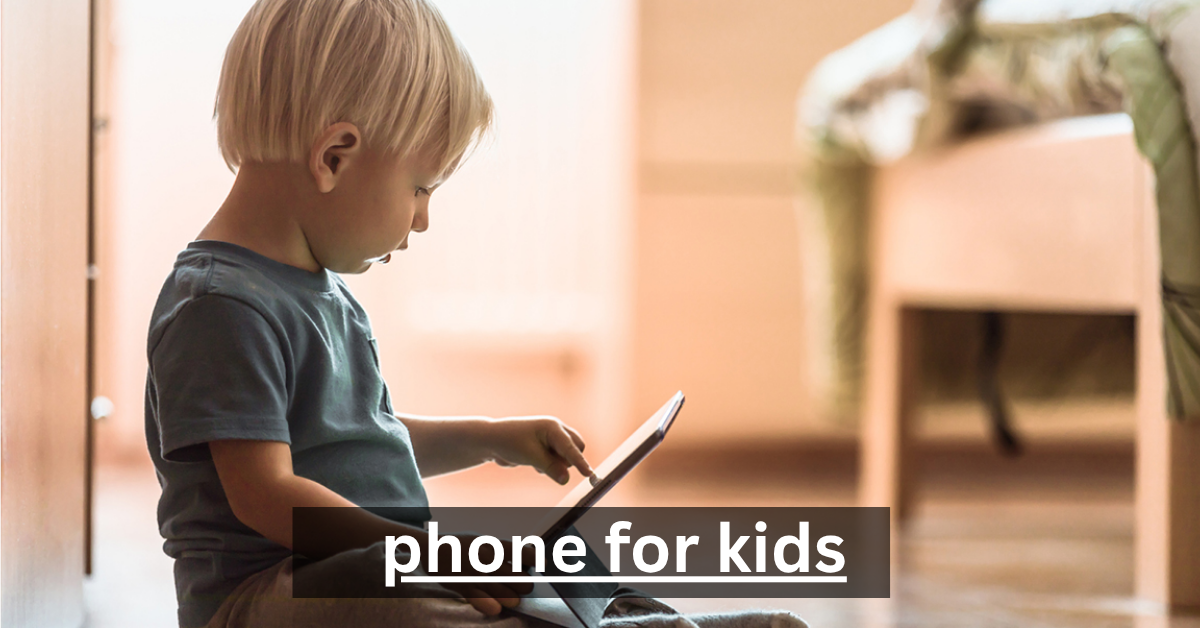Phone for Kids, such as Pinwheel or Gabb Wireless, provides smart choices for children with strong parental controls and safe content filters. From staying connected with parents to ensuring safety in emergencies, phones for kids provide numerous benefits. However, as children are more vulnerable to online risks and distractions, choosing the right device is crucial.
Phones for kids are designed to provide both safety and learning opportunities while ensuring that parents maintain control over their child’s digital experience. This guide will explore everything you need to know about kids’ phones, from essential features to top devices, and how to set up digital boundaries to protect your child.
When choosing a phone for your child, safety should be your number one priority. Kids are naturally curious, and with access to the internet, they are exposed to countless opportunities for learning, but also significant risks. Parental controls, content filtering, and GPS tracking are essential features that help keep kids safe.
Phones designed for kids come with built-in safety mechanisms that allow parents to monitor usage, block inappropriate content, and limit screen time. This peace of mind ensures that kids can enjoy the benefits of technology while minimizing the risks.
What This Guide Will Cover
In this guide, we will explore the essential features to look for in a phone for kids, review top phone options in 2025, and provide tips on how to use parental controls effectively. We’ll also discuss alternatives to smartphones, how to set healthy digital boundaries, and provide insights into the right age for giving your child their first phone. By the end, you’ll have all the information you need to make an informed decision about your child’s first phone.
Why Your Child Needs a Phone
Safety and Emergency Contact
One of the primary reasons kids need a phone is for safety. A phone provides a direct line of communication in emergencies, whether it’s a medical situation or needing help getting home. In a world where unforeseen circumstances can arise, having a phone allows children to contact their parents or guardians instantly. This is particularly important for tweens and teens who are often out of the house, involved in activities like school events, sports, and visits to friends.
Encouraging Independence While Maintaining Control
Giving your child a phone encourages independence while still allowing you to monitor their activities. It teaches responsibility as they learn to manage their time and the apps they use. With the right parental controls, you can provide the freedom they need while maintaining a level of oversight that ensures their safety. Phones can also help children stay organized, with access to calendars, reminders, and educational apps.
Educational Benefits and Access to Learning Tools
A phone can be an excellent tool for education, with apps designed for learning and academic improvement. Educational apps for children cover everything from math and science to languages and arts, offering interactive content that helps children learn in fun and engaging ways. Smartphones can also help with research and project management, making them versatile tools that can enhance your child’s educational experience.
Essential Features to Look for in a Phone for Kids
Parental Controls (App Management, Screen Time, Content Filtering)
A key feature of any phone for kids is giving parents the power to monitor activity and manage how the device is used. Parental controls allow you to manage which apps your child can download, ensuring that they only have access to age-appropriate content. You can set daily screen time limits to prevent overuse, which is essential in promoting healthy screen time habits.
Content filtering is also crucial to block inappropriate websites and apps that may pose a risk to your child’s digital safety. With these features, you can ensure that your child’s phone is a safe space for communication and learning.
GPS Tracking and Real-Time Location Monitoring
GPS tracking is another vital feature of phones for kids, providing parents with the ability to monitor their child’s location in real time. This feature can give parents peace of mind knowing where their child is, whether they’re at school, a friend’s house, or out for a walk. Some phones also offer geofencing, which allows you to set safe zones for your child, such as their school or home. You will receive an alert if they leave these designated areas.
Durability and Rugged Design
Kids are known for being rough on their possessions, so durability is a must-have feature. A rugged design ensures that the phone can withstand accidental drops, spills, and other mishaps. Phones with shockproof and water-resistant features are ideal for children, as they can handle everyday wear and tear. Additionally, pairing the phone with a sturdy protective case can prolong its life and keep it in good condition.
Child-Friendly Interface and Easy Navigation
The phone should be easy to navigate, especially for younger kids who may not be familiar with complex devices. Phones designed for kids often feature simplified interfaces and large buttons to make navigation intuitive. Look for phones that have customizable home screens where you can prioritize the most useful apps for your child’s age and needs.
Top Phones for Kids in 2025
Pinwheel: The Phone with Built-In Parental Control Features
Pinwheel is one of the top choices for a phone designed specifically for kids. It comes with integrated parental control features that allow you to manage app downloads, set screen time limits, and monitor your child’s phone activities. With a simple, easy-to-use interface and a focus on safety, Pinwheel provides a secure environment for children while giving parents complete control over their child’s phone experience.
Gabb Wireless: Phone for Kids with No Internet Access
Gabb Wireless offers a phone that provides all the essential features for communication without the distractions and risks associated with the internet. The phone is equipped with calling, texting, and GPS location tracking features, but it does not have access to social media or web browsing. This makes it a great option for parents who want to limit their child’s exposure to the internet while still providing a device for communication.
Troomi: A Kid-Friendly Phone with Focus on Safety
Troomi delivers a kid-friendly smartphone experience with a curated selection of apps and robust parental controls. Parents can approve apps, set screen time limits, and monitor their child’s location in real time. With a focus on digital safety and education, Troomi is an excellent choice for parents looking for a safe phone for their kids.
TickTalk: A Smartwatch for Kids with Parental Monitoring Features
TickTalk offers a smartwatch designed specifically for kids. With calling, texting, and GPS tracking capabilities, TickTalk is a great option for younger children who may not be ready for a full smartphone. The watch includes parental controls that allow you to monitor your child’s usage, set screen time limits, and track their location.
Other Notable Options: Jitterbug, SafeWise, and More
Other notable phones for kids include Jitterbug, which offers simple, easy-to-use features for seniors and children alike. SafeWise provides reviews and recommendations on safe phones for kids, helping parents make informed choices. Exploring these options will give you a range of devices to choose from, depending on your child’s needs and your family’s preferences.
How to Use Parental Control Features Effectively
Setting Screen Time Limits
Screen time management is essential in today’s digital age. Setting daily screen time limits ensures that your child does not spend excessive hours on their phone, helping to prevent tech addiction and promoting healthy habits. Most phones for kids come with built-in options to restrict usage during specific times, such as bedtime, to encourage healthy sleep patterns.
Managing App Downloads and Usage
Parents should monitor app downloads to ensure that their child is not accessing inappropriate content. Many phones for kids allow parents to approve or block app downloads before they are installed. Regularly reviewing your child’s apps and usage will help you ensure that they are only engaging with age-appropriate content.
Blocking Inappropriate Content and Sites
Content filtering is a vital feature of phones for kids. By blocking access to adult content, social media, and potentially harmful websites, you can safeguard your child from exposure to inappropriate material. Set up filters based on your child’s age and interests to maintain a safe browsing experience.
Monitoring Location with Geo-Fencing
Geo-fencing is an excellent tool for parents to monitor their child’s location and ensure they stay within safe zones. Set up geofences around your home, school, or other approved areas. Receive instant alerts if your child leaves these areas, allowing you to take action if necessary.
Alternatives to Smartphones for Younger Kids
Basic Phones vs. Smartphones
For younger kids, a basic phone can provide all the necessary communication features without the distractions of a smartphone. Basic phones allow for calling and texting but lack internet access, which helps prevent children from becoming overwhelmed by the digital world.
Why Some Parents Prefer Smartwatches Over Phones
Smartwatches for kids are an excellent alternative to smartphones, offering a safer and more controlled way to stay in touch. With features like calling, texting, and location tracking, smartwatches provide all the benefits of a phone without the added risks of internet access and social media.
Benefits of Delaying Smartphone Usage
Many experts recommend delaying smartphone usage until your child is older. Limiting phone access allows children to focus on physical activities, hobbies, and face-to-face social interactions. It also helps prevent early exposure to digital distractions and online risks.
Setting Healthy Digital Boundaries
Creating Screen Time Rules
Establishing clear rules about screen time is essential in fostering healthy tech habits. Set guidelines for when and how long your child can use their phone each day, ensuring they have plenty of time for other activities, such as homework, reading, and outdoor play.
Encouraging Outdoor Play and Non-Screen Activities
Encouraging your child to engage in outdoor activities and hobbies helps create a balanced lifestyle. While phones can be useful for learning, it’s important to make sure that your child has time away from screens to develop other essential skills and foster creativity.
Family Phone Policies and Phone-Free Zones
Establishing family-wide phone policies and phone-free zones can encourage face-to-face interactions and limit distractions. For example, consider making the dining table and bedrooms phone-free zones to encourage quality family time and healthy sleep habits.
Managing Your Child’s Digital Well-Being
The Importance of Educating Kids About Online Safety
Teaching your child about online safety is one of the most important things you can do. Discuss the risks of cyberbullying, online predators, and inappropriate content. Encourage open communication, so your child feels comfortable coming to you with any concerns about their digital experience.
Preventing Cyberbullying and Ensuring Privacy
Cyberbullying is a serious issue that can affect children of all ages. Ensure your child knows how to protect their privacy online, avoid sharing personal information, and report any instances of cyberbullying. Establish clear guidelines for social media use and ensure that privacy settings are adjusted for maximum security.
Teaching Responsible Phone Usage and Digital Manners
Teaching your child responsible phone usage helps them understand the importance of etiquette and mindfulness while using their devices. Encourage them to use their phones for good, such as for educational purposes, and teach them about respecting others’ boundaries online.
The Debate: When is the Right Age for a Phone?
The Impact of Phones on Child Development
The right age for a phone depends on many factors, including the child’s maturity level and the purpose of the device. While phones offer benefits, they also present challenges, such as potential distractions, risks to mental health, and cyberbullying. It’s important to consider these factors before introducing a smartphone to your child.
Age-Appropriate Guidelines for Introducing a Phone
Age-appropriate guidelines vary, but many experts suggest that children should not have their first smartphone until they are at least 12 years old. Consider your child’s responsibility level and readiness to handle the device before making the decision.
Tips for Managing Phone Introduction to Avoid Overuse
To prevent overuse, establish rules for phone usage, such as limiting screen time and ensuring the phone is used for productive activities. Gradually introduce your child to the phone to avoid overwhelming them with digital distractions.
Conclusion
When choosing a phone for your child, prioritize safety, parental controls, and educational features. Look for devices with GPS tracking, content filtering, and rugged designs that can withstand the wear and tear of daily use. Top options like Pinwheel, Gabb Wireless, and Troomi offer excellent safety features, while alternatives like smartwatches can provide a safer, more controlled experience for younger kids.
Remember, it’s important to stay involved in your child’s digital experience. Regularly monitor their usage, set boundaries, and foster open communication about online safety. With the right tools and mindset, you can ensure that your child’s first phone experience is positive and empowering.
Encouragement to Choose Wisely Based on Your Child’s Needs and Maturity
Ultimately, the best phone for your child depends on their individual needs and maturity. Choose wisely, keeping in mind both their safety and development. By providing the right device and support, you can help them navigate the digital world responsibly.
Frequently Asked Questions
At what age should I give my child a phone?
While it varies, many experts recommend giving children a phone around 12 years old, depending on their maturity and responsibility.
How can I monitor my child’s phone usage?
Using parental control apps like Google Family Link or Bark can help you monitor app usage, set screen time limits, and track your child’s location.
Can I block internet access on my child’s phone?
Yes, phones like Gabb Wireless offer phones without internet access, and others allow you to limit internet use through parental controls.
Stay in touch to get more updates & alerts on Erome! Thank you



